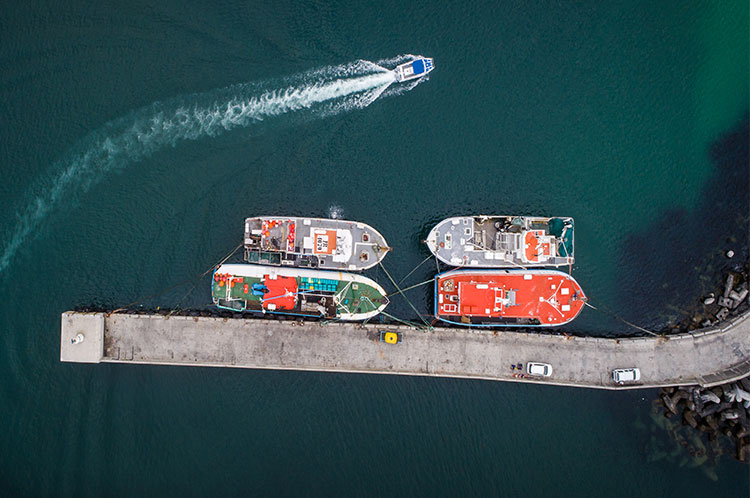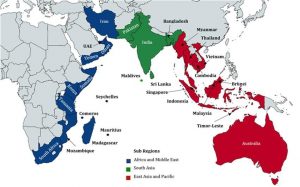The Importance of the Indian Ocean: Trade, Security and Norms
October 5, 2018 Reading Time: 5 minutes

Reading Time: 5 min read
Image Credit: dewald@dewaldkirsten/depositphotos
Pabasara Kannangara, Adam Collins and Barana Waidyatilake*
This LKI Explainer examines the key aspects of the Indian Ocean region and its importance. It highlights some of the emerging challenges faced by the region and introduces UNCLOS as vital framework to regulate maritime activity.
Contents
- What is the Indian Ocean Region?
- Why is the Region Important?
- The Law of the Sea
1. What is the Indian Ocean Region?
- The Indian Ocean region consists of 28 states, spans across three continents and covers 17.5% of global land area.
- These 28 countries include 21 members of the Indian Ocean Rim Association (Australia, Bangladesh, Comoros, India, Indonesia, Iran, Kenya, Madagascar, Malaysia, Mauritius, Mozambique, Oman, Seychelles, Singapore, Somalia, South Africa, Sri Lanka, Tanzania, Thailand, United Arab Emirates and Yemen), and Brunei, Cambodia, the Maldives, Myanmar, Pakistan, Timor-Leste and Vietnam.
- In 2017, this region was home to 35.0% of the world’s total population (2.6 billion people).
Figure 1: The Indian Ocean Economy

Source : LKI
Why is the Region Important?
2.1 Rich Resource Base
- The Indian Ocean holds 16.8% of the world’s proven oil reserves and 27.9% of proven natural gas reserves.1
- Indian Ocean economies accounted for 35.5% of global iron production and 17.8% of world gold production in 2017.2
- The region was also responsible for 28% of global fish capture in 2016, and there has been a continuous increase in fish capture in the region since the 1950s.
- This has created a successful basis for export industries in a number of countries. For example, Indonesia and India accounted for around 4.5% of global frozen fish exports in 2017.
- This abundance of natural resources, among other factors, has facilitated trade-led growth within this region.
2.2 Maritime Trade
- The Indian Ocean is home to major sea routes connecting the Middle East, Africa and East Asia with Europe and the Americas.
- These vital sea routes (i) facilitate maritime trade in the Indian Ocean region, (ii) carry more than half of the world’s sea-borne oil,3 and (iii) host 23 of the world’s top 100 container ports.
- Container traffic through the region’s ports has increased fourfold from 46 million TEUs in 2000 to 166 million TEUs in 2017.
- According to the 2017 Lloyd’s List, the top Indian Ocean container ports are Singapore (34 million TEUs), Dubai (15 million TEUs) and Port Klang in Malaysia (13 million TEUs).
- Between 2011 and 2017, the average annual growth of container traffic through the leading regional ports of Singapore and Dubai has averaged 2.6% and 3.8%, respectively.
- Interestingly, smaller ports have experienced greater growth than larger ports in the region, such as the Port of Colombo in Sri Lanka and Mombasa in Kenya, which averaged 6.1% and 8.8%, respectively.
- Increased connectivity within the region has strengthened ties with external trading partners.
- China has emerged as the most important trading partner of the Indian Ocean region, accounting for 16.1% of its total goods trade in 2017, up from 4.8% in 2000.
- On the other hand, between 2000 and 2017 the share of trade has declined with other major partners such as the EU (16.8% to 12.0%), the US (13.9% to 7.9%), and Japan (14.6% to 6.5%).
- Intra-regional trade is even stronger, accounting for 27.2% of total trade in 2017.
2.3 Emerging Threats
- Freedom of navigation is vital for the smooth flow of Indian Ocean maritime trade but threats such as competition among great powers, nontraditional security threats, and environmental degradation remain.
- Piracy and drug trafficking are gaining traction within the region.
- In 2012, 200 kgs of heroin was trafficked on the Indian Ocean maritime trade routes. This increased to nearly 4500 kgs of heroin trafficked between May 2015 and May 2016.4
- Out of a total of 180 global incidents of piracy, 84 (46.7% of the global total) occurred within this region in 2017,5 undermining the safety and the security of maritime trade and other related activities.
- Environmental degradation also poses a threat to the growth of the region. Unsustainable use of marine resources may lead to rapid depletion of fish stocks and other minerals.
- This could adversely impact the region’s economic prosperity as some major economies depend on these resources to stimulate trade and economic growth.
- The lack of a regional maritime security architecture has prompted major powers to compete for control over these resources and sea-lanes.
- The further escalation of such geopolitical tensions, as seen in the South China Sea, would threaten the openness of the region’s sea routes, which in turn may disrupt trade and adversely affect energy dependent nations like Sri Lanka.
3. The Law of the Seas
- The United Nations Convention on the Law of the Sea (UNCLOS)6 is an international treaty which was adopted and signed in 1982. The Convention has become the legal framework for global marine and maritime activities, and is known as the ‘Constitution of the Seas.’
- Since its adoption, 167 states have joined the treaty, out of which 25 are Indian Ocean states. Only three—Cambodia, Iran and the UAE—are not party to the treaty.
- The Convention aims to delineate all ocean space into different maritime zones and sets forth the rights and duties of States in their activities within each of those maritime zones.
- It divides the ocean into six different zones namely; Internal waters, Contiguous Zone, Territorial Sea, Exclusive Economic Zone (EEZ) and High Seas.7
- The main institutions established by the Convention include8 :
- The International Tribunal for the Law of the Sea;
- The Commission on the Limits of the Continental Shelf; and
- The International Seabed Authority.
- As this Convention forms the core of ocean governance, Indian littoral states and maritime users can use this as a foundation for ensuring freedom of navigation and stability in the Indian Ocean.
4. Key Readings
Wignaraja, G., Collins, A. and Kannangara, P. (2018). Is the Indian Ocean Economy a new Global Growth Pole?. Lakshman Kadirgamar Institute Working Paper Series. Available at: https://lki.lk/publication/is-the-indian-ocean-economy-a-new-global-growth-pole/
UN General Assembly, United Nations Convention on the Law of the Sea. 10 December 1982. Available at: http://www.un.org/depts/los/convention_agreements/texts/unclos/unclos_e.pdf
Notes
1 British Petroleum (2017). BP Statistical Review of World Energy 2017. [online] pp.12-34. Available at: https://calculators.io/statistical-review-of-world-energy/.
2 Bgs.ac.uk. (2018). World Mineral Statistics Data | Statistics & Commodities | MineralsUK. [online] Available at: https://www.bgs.ac.uk/mineralsUK/statistics/wms.cfc?method=listResults&dataType=Production&commodity=71&dateFrom=2015&dateTo=2016&country=&agreeToTsAndCs=agr.
3 Cordner, L. (2010), “Rethinking Maritime Security in the Indian Ocean Region.” Journal of the Indian Ocean Region, 6(1), pp.69.
4 Janes (2017). Drug trafficking routes proliferate through Indian Ocean. Jane’s Intelligence Review. [online] pp.1-5. Available at: https://www.janes.com/images/assets/457/72457/Drug_trafficking_routes_proliferate_through_Indian_Ocean.pdf.
5 ICC International Maritime Bureau (2018). 2017 Annual Report on Piracy and Armed Robbery Against Ships. [online] Available at: https://www.icc-ccs.org/reports/2017-Annual-IMB-Piracy-Report.pdf
6 UN General Assembly, United Nations Convention on the Law of the Sea.10 December 1982. Available at http://www.un.org/depts/los/convention_agreements/texts/unclos/unclos_e.pdf
7 Sites.tufts.edu. (2018). Chapter 2: Maritime Zones – Law of the Sea. [online] Available at: https://sites.tufts.edu/lawofthesea/chapter-two/ [Accessed 5 Oct. 2018].
8 James, H. (2015). 17 The Law of the Sea Convention Institutions. The Oxford Handbook of the Law of the Sea. Available at: http://www.oxfordhandbooks.com/view/10.1093/law/9780198715481.001.0001/oxfordhb-9780198715481-e-17#oxfordhb-9780198715481-e-17-div1-1
Abbreviations
TEU Twenty-Foot Equivalent Unit
EU European Union
US United States
UNCLOS United Nations Convention of the Sea
EEZ Exclusive Economic Zone
∗Pabasara Kannangara is a Research Associate at the Lakshman Kadirgamar Institute of International Relations (LKI). Barana Waidyatilake and Adam Collins are Research Fellows at LKI. The opinions expressed in this article are the authors’ own views. They are not the institutional views of LKI, and do not necessarily represent or reflect the position of any other institution or individual with which the authors are affiliated.
